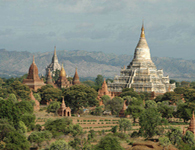Even though it is somewhat similar to the food found in the northeastern part of Thailand in the area known as Isan, Lao food is distinct from other Asia cuisines. Due in part to the fresh foods local to each region, Lao cuisine has many regional variations. Indochina travel Laos

Laos chicken laap with sticky rice -source: internet
Sticky rice is one of the staples of Laos’ food
As its name reveals, glutinous rice sticks together naturally so it is easy to roll into petit balls, dip into sauce and enjoy with your own fingers. Normally, it is prepared freshly and not preserved. It is likely that no one can leave this Southeast Asian country without trying many meals of the versatile staple of Laotian cuisine – sticky rice.
What explains the love of sticky rice of all Laotians?
Sticky rice is what their great-grandparents, grandparents and parents ate. Like sushi in Japan and baguettes in France, sticky rice in Laos is so ingrained in the stunning national culinary heritage of that most Laotians do not think about it in isolation.

Lao sticky rice -source: internet
In mainland Southeast Asia, sticky, also known as glutinous rice has been growing for more than 4,000 years. Historians have debated whether ancient farmers grew sticky rice because they liked its taste and chewy texture or because it was suited to local growing conditions. What’s clear is that, by the 18th century, across the region, varieties of non-glutinous rice, or white rice had largely replaced sticky rice. Per-capita sticky rice consumption in Laos is the highest on earth at over 345 pounds per year.
The rice-consumption habits across Laos have been altered to the point where some urban dwellers now associate sticky rice with country bumpkin ways of eating by migration, urbanization and other forces. But it is hard to find a single Laotian who has never eaten sticky rice. Sticky rice is still regarded as the way Laotians identify themselves.

Sticky rice is still regarded as the way Laotians identify themselves -source: internet
Although dishes made from rice come in various sizes and shapes, the basic method of consuming khao niaw is the same countrywide. After being harvested, sticky rice grains that are normally fatter and shorter than non-glutinous ones, are soaked overnight, steamed in the very early morning and served all day long.
Even though sticky rice still tastes great after two steaming times, steaming it thrice will make it too much sticky. Because sticky rice lacks the starch amylose, under the same cooking conditions, it congeals and breaks off into fist-sized pieces much more easily than non-glutinous rice. Indochina bike tours

Why sticky rice is the traditional cuisine of Laos – source: internet
A mouthful of sticky rice is a really mouthwatering and bread-like dipping implement. Rather than with just sauces and curries, Laotians prefer to enjoy sticky rice with non-soupy dishes.
Across Laos, where the predominant faith is Theravada Buddhism, sticky rice figures in religious traditions. For ceremonies related to harvests, rainfall, death and plantings, Laotians cook sticky rice dishes — notably khao tom, a fusion of sticky rice, mung bean, banana and coconut. During the popular baci ceremony, after communal prayers, uncooked sticky rice grains are tossed into the air. And when a Laotian is dying, an elder in the village use sticky rice to rub on the person and throw the rice away to dismiss all the bad spirits.

All Laotians love sticky rice -source: internet
But sticky rice is not only spiritual fuel. It sates hunger for longer periods as it takes longer to digest than white rice does. It is really good for Laotian monks, who normally do not eat after midday.









